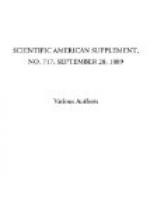To my then young and enthusiastic mind it seemed that in ozone we had a means of stopping all putrefaction, of destroying all infectious substances, and of actually commanding and destroying the causes which produced the great spreading diseases; and, although increase of years and greater experience have toned down the enthusiasm, I still believe that here one of the most useful fields for investigation remains almost unexplored.
In my first experiments I subjected decomposing blood to ozone, and found that the products of decomposition were instantly destroyed, and that the fluid was rendered odorless and sweet. I discovered that the red corpuscles of fresh blood decomposed ozone, and that coagulated blood underwent a degree of solution through its action. I put dead birds and pieces of animal substances that had undergone extreme decomposition into atmospheres containing ozone, and observed the rapidity with which the products of decomposition were neutralized and rendered harmless. I employed ozone medicinally, by having it inhaled by persons who were suffering from foetor of the breath, and with remarkable success, and I began to employ it and have employed it ever since (that is to say, for thirty-seven years), for purposes of disinfection and deodorization, in close rooms, closets, and the like. I should have used it much more largely but for one circumstance, namely, the almost impracticable difficulty of making it with sufficient ease and in sufficient quantities to meet the necessities of sanitary practice. We are often obstructed in this way. We know of something exceedingly useful, but we cannot utilize it. This was the case with ozone. I hope now that difficulty is overcome. If it is, we shall start from this day on a new era in regard to ozone as an instrument of sanitation.
As we have seen, ozone was originally made by charging dry oxygen or common dry air with electricity from sparks or points. Afterward Faraday showed that it could be made by holding a warm glass rod in vapor of ether. Again he showed that it could be made by passing air over bright phosphorus half immersed in water. Then Siemens modified the electric process by inventing his well known ozone tube, which consists of a wide glass tube coated with tinfoil on its outside, and holding within it a smaller glass tube coated with tinfoil on its surface. When a current of dry air or oxygen was passed in current between these two tubes, and the electric spark from a Ruhmkorf coil was discharged by the terminal wires connected with tinfoil surfaces, ozone was freely produced, and this was no doubt the best method, for by means of a double-acting hand bellows currents of ozone could be driven over very freely. One of these tubes with hand bellows attached, which I have had in use for twenty-four years, is before the meeting, and answers as well as ever. The practical difficulty lies in the requirement of a battery, a large coil, and a separate bellows as well as the tube.




